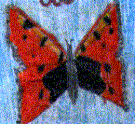
St. Kilian
St. Kilianís N.S.

St. Kilian
|
St. Kilian |
St. Kilianís N.S. |
St. Kilian |
|
Nature
News
Butterflies
|
|||
 |
The
Small Tortoiseshell† Butterfly
by Emma and Louise The small tortoiseshell butterfly is found all over the
place.† Like all butterflies, it
starts as an egg.† It hatches and
then it is a caterpillar.† After
a while it goes to sleep in a chrysalis.†
On a sunny day, it will become a butterfly.† The caterpillarís food is a stinging nettle.
|
|||
| The tortoiseshell gets its nectar from garden
plants like daisies, sedum or buddleia.†
We have all these around our school.†
It often makes a chrysalis at the top of curtain folds. We mostly see the tortoiseshell around June or July.† The colours are orangey-red, yellow and black.† They are mostly orangey red.† We used to mix up the tortoiseshell and the red admiral but now we know the difference. |
||||
|
|
||||
The
Peacock† Butterfly
by Michelle and Sarah
The peacock butterfly lays its eggs on nettles.† This butterfly is not as common as some other butterflies around our school.† The peacock is a European butterfly.† It is common in July. |
 |
|||
|
The peacock has four eyes on each side on the top and bottom.† The peacock has the colours of the rainbow.† The wing of the butterfly is covered in thousands of tiny scales of different colours.† It is dull brown on the underside but it is brightly coloured when itís open. |
||||
|
|
||||
 |
The
Red Admiral Butterfly
by Doireann and Lynn The
red admiral butterfly is red and black with white spots.† The male and female are similar.† The red admiral lays a single egg on a nettle
leaf. |
|||
|
We
find a lot of them sucking nectar on the sedum plants at the school gates
when we come back in September.† People
think that they are the most beautiful of butterflies. |
||||
|
|
||||
|
Early in May we went on a nature walk.†
We found lots of orange tip butterflies and small white butterflies
together.† They were flying around the lady smock along
the side of the road.† The orange
tip lays her eggs on lady smock. |
 |
|||
|
† Butterflies like many insects change as they grow.† This change is called metamorphosis.† When the butterfly lays her eggs on a flower or leaves it hatches out and is a small caterpillar.† Months or weeks later it hatches out of its pupa and it is a lovely colourful butterfly. |
||||
|
|
||||
 |
The Large White ButterflyBy SeŠn and Jade We sometimes see the large white butterfly around our school.† We see them mostly from May to September.†† They feed on nasturtiums. The female lays her eggs on a plant.† The eggs are laid in batches and appear dark yellow.†The egg stage is usually about a week.† The eggs are laid on cabbages.† The caterpillar turns into a pupa. |
|||
|
When it is ready to come out of the pupa it will start to shake.† It is wet and soggy when it comes out first.†
It flies around until it has dried off.†
Then it finds a mate and starts again. |
||||
|
|
||||